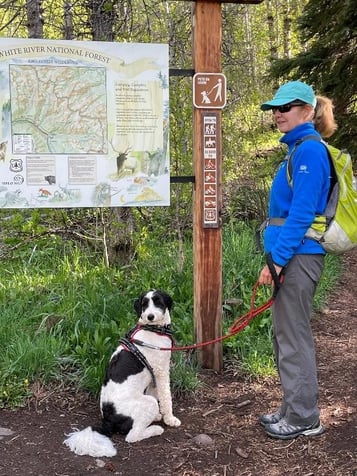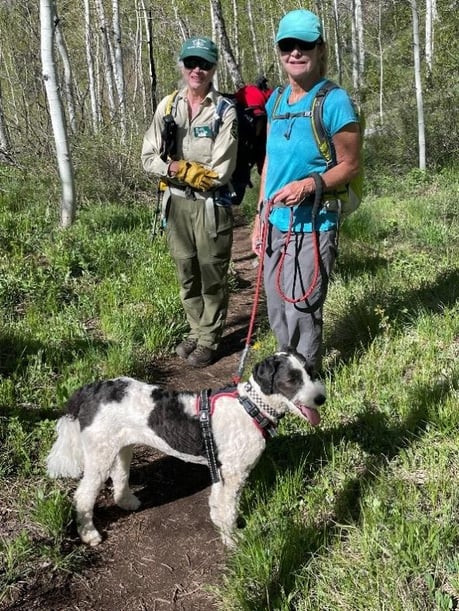Dog lovers know the delight of sharing nature with our canine companions. Dogs’ sheer joy in the outdoors enhances our own, and their great sense of hearing and smell can draw our attention to aspects of the natural world that might otherwise go unnoticed.
How can we ensure our dogs can enjoy wilderness without suffering or causing harm?
Leashing Your Dog on Trails
Fortunately, the solution is as simple as leashing your dog on trails. Locally, public lands are managed with different leash regulations. Consistently using a leash protects both the safety of your dog and the health and safety of the environment and its inhabitants. We enjoy easy access to the Eagles Nest Wilderness, where regulation requires leashing: “Pets are required to be on a leash to protect wildlife, other visitor’s experience and your privilege to have them with you.”
How does leashing protect your dog, our alpine environment, and you? Leashing helps protect dogs from getting lost (including spooked by sudden weather changes like thunder), caught in natural hazards like fast-flowing streams, or attacked by wildlife including moose, mountain lions, bears, porcupines, and other animals that perceive unleashed dogs as threats.

Pam and Piper ready to head up Pitkin Lake Trail.
How Does Leashing Protect Your Dog?
How does leashing protect your dog, our alpine environment, and you? Leashing helps protect dogs from getting lost (including spooked by sudden weather changes like thunder), caught in natural hazards like fast-flowing streams, or attacked by wildlife including moose, mountain lions, bears, porcupines, and other animals that perceive unleashed dogs as threats.
Leashing also helps protect you from attacks by wildlife your dog might disturb. Many moose attacks involve unleashed dogs. Colorado Parks and Wildlife cautions “Moose see dogs as predators and will attack aggressively” and “Always keep your dog on a short leash and under control.” In summer, moose protecting their young are especially dangerous.
Leashing helps you monitor your pet for dehydration, sore paws, exhaustion, overheating, and other risks. Consider if the hike you are attempting is appropriate for your dog’s health and fitness before bringing a pet along. For their safety, dogs, like humans, may need to build up their hiking strength before attempting longer or more strenuous adventures.
How Does Leashing Protect Wilderness and Alpine Areas?
How can we protect wilderness and alpine areas from canine impacts? Again, leashing is key, along with staying on the trail. This minimizes your pup’s negative impacts, including stressing wildlife, dispersing noxious weeds like seeds hitchhiking on paws and coats, trampling delicate native plants, contaminating streams and lakes, and disturbing other users.
Dog owners are more likely to clean up after leashed pets. Contaminants in dog waste, like E. coli and cryptosporidium, can sicken wildlife. Dog waste causes green algae blooms that consume oxygen in alpine lakes and streams, killing fish and aquatic plants. Dog waste is high in nitrogen and phosphorus, allowing invasive plants to outcompete delicate natives. So, bag waste, place the bag in a reusable bag designed to avoid smelly backpacks, and carry it out.
In the fragile alpine tundra above treeline, where unique animals and plants struggle to survive in harsh conditions, leashing your pet is crucial. Pikas, for example, must conserve energy while storing food to survive long winters. However, pikas, whose squeaks sound like a dog toy, can be injured or killed by unleashed dogs, as observed in the Holy Cross Wilderness after the leash rule was dropped in 2013.
In the alpine zone, Leave No Trace.org recommends leashing and staying on trail: “With a few frolics in a sensitive alpine ecosystem, dogs can quickly cause a lot of unintentional destruction. Help your dog travel and camp on durable surfaces in the alpine by keeping them on their leash.”
Leashing your dog helps you to be a better steward of the land when visiting wilderness and alpine environments. There are penalties for violating Forest Service regulations.
 Pam and Piper with ESWA Volunteer Wilderness Ranger Ellie, Pitkin Lake Trail.
Pam and Piper with ESWA Volunteer Wilderness Ranger Ellie, Pitkin Lake Trail.
Additional Info on Leashing Your Dog on Trails
Looking for help with leash training? Free training sources are available locally, online, at your library, and through animal shelters.
So, remember: “Love ‘em? Leash ‘em”--and protect your dog, yourself, and our wilderness and alpine areas. Kudos to dog owners who follow regulations and respect wildlife, wilderness, and fellow users!
Frances Hartogh is a Volunteer Wilderness Ranger for ESWA, the Eagle Summit Wilderness Alliance.









